This article about teaching piano arranging was written by Stacy Fahrion. Stacy is a composer, pianist, educator, and perpetual student based in Colorado, USA. Her music – including both whimsically macabre arrangements and original pieces – can be viewed and listened to in the Piano Pronto Composers Community. Find out more about Stacy and whatever new thing she’s up to at her website, Whimsically Macabre, or by subscribing to her YouTube channel.
Arranging music is one of the most useful skills pianists can learn. It’s also a wonderfully practical way to work on ear training and learn about harmony, and a gateway to composing original music. But if you’re new to the idea, teaching piano arranging can be intimidating.

Teaching students about arranging piano music doesn’t have to be scary. In this article, I’ll walk you through my 4-step process for teaching piano arranging by using the children’s song The Itsy Bitsy Spider.
I’m using a folk song in this example, but this method also works well if students want to learn the chorus of a pop song. Just be sure to break it down into small, manageable sections.
Arranging Music Step 1: Choose a Favourite Tune or Piece
Let’s say your student has chosen Itsy Bitsy Spider for her arranging project. Now it’s time to help her hone in on exactly what appeals to her about that choice.
Have your student listen to the tune repeatedly and list out all the things she loves about it. Then gently guide her to land on the main overarching thing which resonates with her.
Maybe, she admires the persistence of the spider. Or maybe the lyrics remind her of her favorite bedtime story, The Myth of Sisyphus.

Whatever the appeal, it’s important that she recognises her personal connection with the music she chose. If the music doesn’t resonate with her, she won’t have anything to draw from when it’s time to make it her own.
Arranging Music Step 2: Work Out the Basics
Melody
Help your student play the melody by ear. Ask her if she notices how each note of a scale has a different feel, like how the tonic feels restful while the dominant wants to move. If she needs help, play a few notes or one phrase at a time and have her echo it.
Metre
Figure out what meter you’re in. Play the song repeatedly for your student, and have her tap (or stomp) to the underlying beat. Next, see if it works to count to 3 or to 4, or even conduct it while counting.
Once your student has figured out how many beats there are in a measure, have her check if the main pulse is divided by 2 or 3. I feel Itsy Bitsy Spider in four, with each beat divided by three. You could notate it in 4/4 time with a swing feel, or in 6/8.
Chords
Work out some chords for the melody. Keep it as simple as possible at first. I usually write the chord symbols above the staff lead-sheet style, so I can try out all sorts of different accompaniments without any visual interference, but it’s OK to write out the actual chords too.
Here’s one possible end result of step 2 in the arranging process:

Practise
Once the basics are all laid out, have your student play the tune over and over until she’s super comfortable with it.
Arranging Music Step 3: Conduct Lots of Musical Experiments
It’s time for your student to make it her own! She’s now a musical scientist, about to conduct lots of musical experiments.
Brainstorm with your student and have her list at least 5 different things she could try. Ask repeatedly, “What would it sound like if…?”
After you’ve had some fun coming up with a list of things to try, instruct your student be silent for a while and check in with how she feels right at that moment. What does she want to express?
Have her decide what she’d like to change first. I recommend changing just one thing at a time. Coach your student to keep doing this and play it every way she can think of.
Here are a few of my favourite experiments I like to conduct when I’m creating my own arrangements. (But don’t read them until you’ve come up with a few yourself! 😜)
Re-harmonise
What would it sound like if…I re-harmonised the melody?
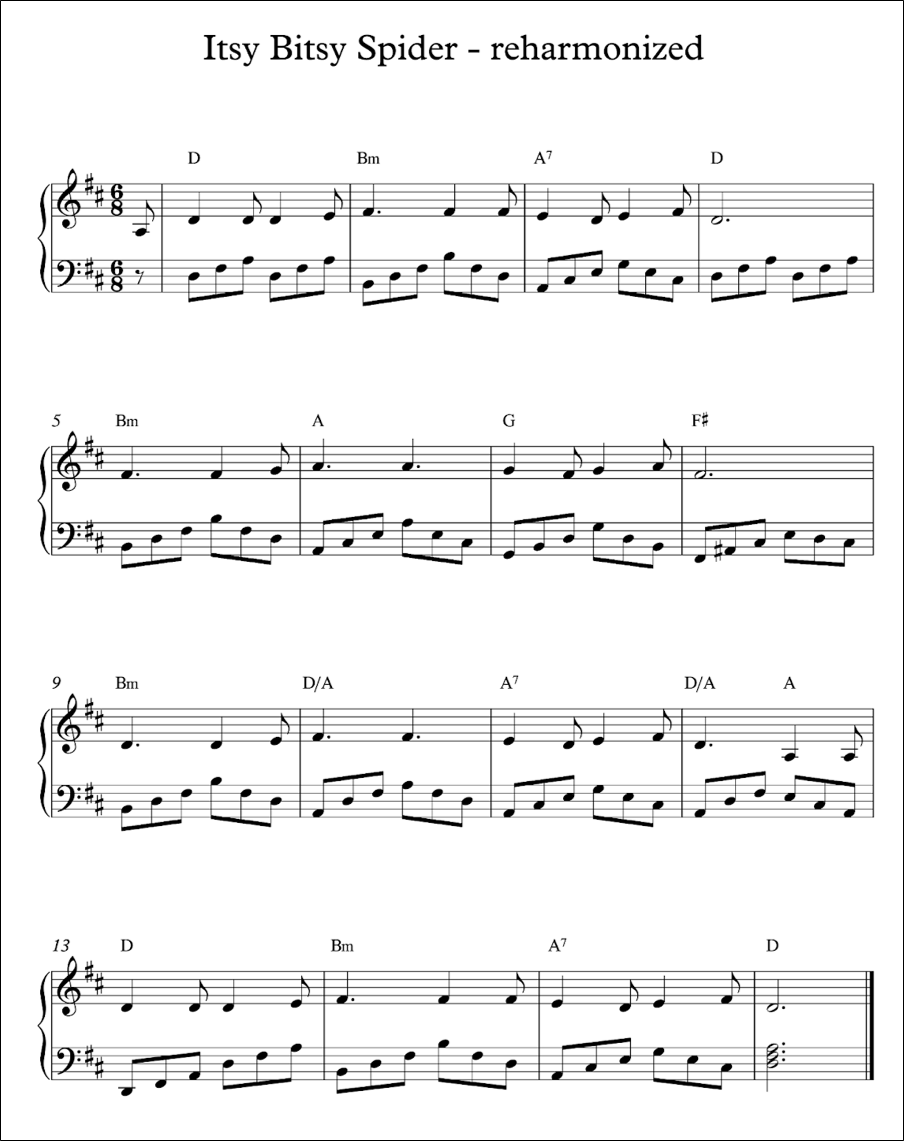
Alter the Scale
What would it sound like if…I altered the scale?
I could switch from major to minor, make it modal, or use one of my favorite scales – double harmonic major (C Db E F G Ab B C.)
Accompaniment Patterns
What would it sound like if…I try a bunch of different accompaniment patterns?
For example, here’s a minor key bluesy version of Itsy Bitsy Spider with a stride left hand:
Different Register
What would it sound like if…I change the register?
I could play at the extreme ends of the piano (either as high as possible or as low as possible.)
Articulation
What would it sound like if…it’s all staccato?
Dynamics
What would it sound like if…it’s all pianissimo, except for one accented chord where I try to scare everyone?
Tempo
What would it sound like if…I radically alter the tempo, shake up the rhythm or change the meter?
Here’s an example of altering the rhythm of the melody, from Arachne’s Web:
Ostinato
What would it sound like if…I use an ostinato accompaniment?
Here’s an example of an Itsy Bitsy Spider mashup with Three Blind Mice, accompanied by an ostinato:
Original Material
What would it sound like if…I add original material in between repetitions of the melody?
I’ll often use a similar chord progression and improvise a new melody over it. One way to think of this is like a Greek chorus commenting on the action of the main theme.
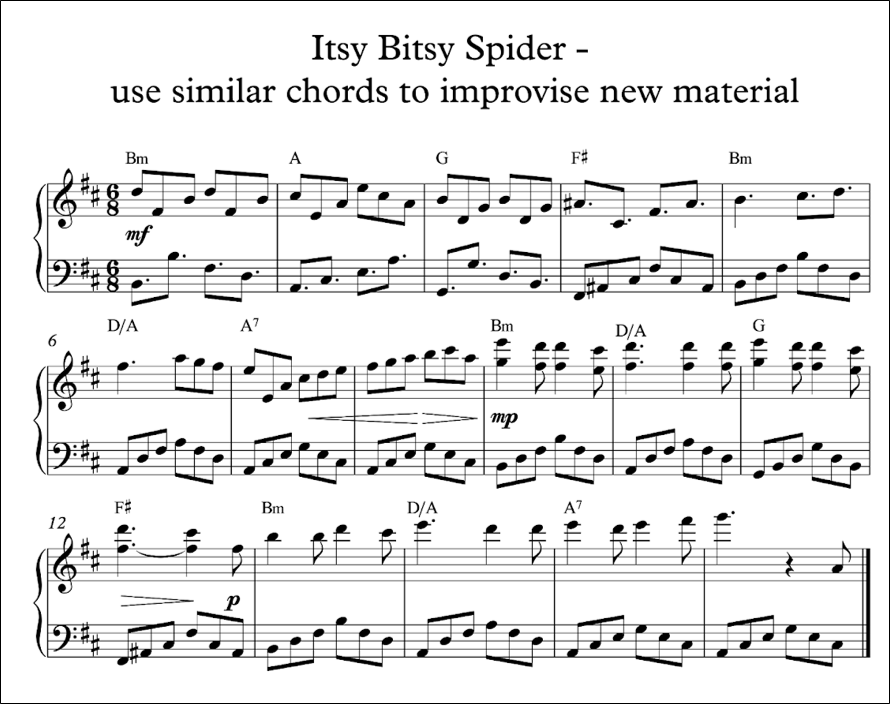
Psssst….need more help incorporating composing and improvising into your lessons? I’ve got just what you need on my Creativity hub page.
Prolonged Reveal
What would it sound like if…I only reveal a little bit of the melody at a time?
Here’s an example of this:
Arpeggios
What would it sound like if…I add some arpeggios?
Notice how I fiddled with the arpeggios in this example so that they didn’t always simply go straight up or down:
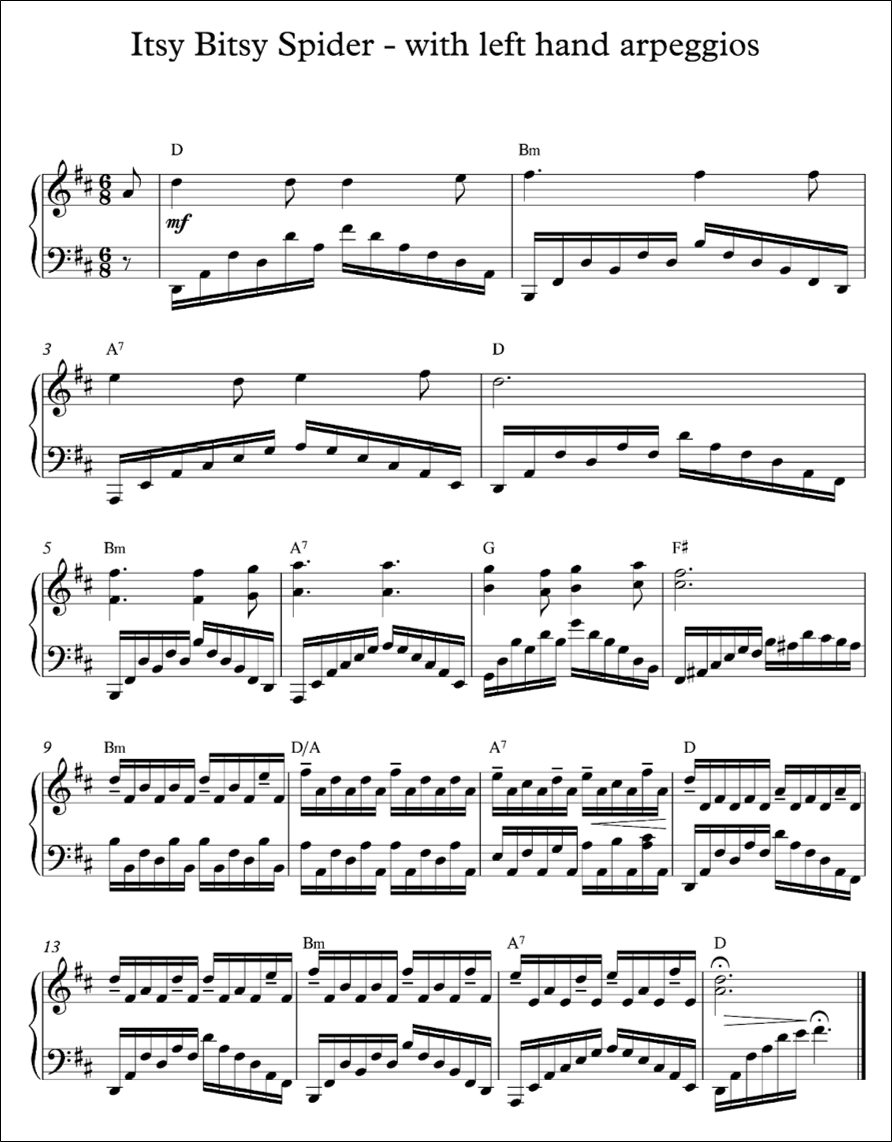
Borrow a Pattern
What would it sound like if…I take a short pattern from my current favorite composer? (Chopin/Joplin/Piazzolla?)
When imitating a pattern, it often helps to identify each chord tone (e.g. root, 3rd, 5th, 7th) and label these in your music.
Arranging Music Step 4: Finish it Off
After conducting all the experiments on your list (and even more, hopefully!), it’s time to make your final choices. Which experiments seemed to bring out what you loved about the original tune?
Decide what your final arrangement is going to sound like, then get it down on paper either by hand or with music notation software such as MuseScore.
Here’s my final arrangement for this project: The Itsy Bitsy Tarantula. I altered the scale to E minor, used an ostinato accompaniment, and added an 8-bar “spider dance” break in between repetitions of the main theme.
But don’t stop there! Record yourself playing it and share it with someone you love. Then rinse and repeat with a new song, or arrange the same song in a different way.
What to Do When You’re Stuck
Make it Horrible
If you’re feeling hesitant or perfectionistic, see how horrible you can make the sound so your inner perfectionist will be appalled and leave you alone. For a wildly dissonant sound, try playing all minor 2nds underneath the melody. This should scare your inner critic off.
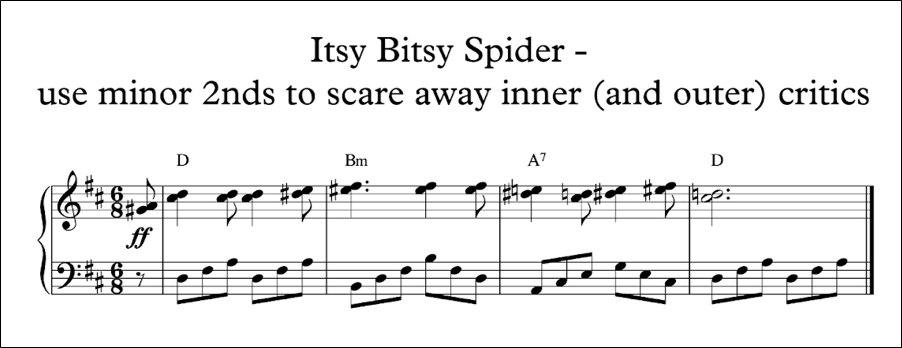
If – after playing these minor 2nds fortissimo – any critic is still pestering you, you know what to do! Tone clusters, with the melody note on top.
If that doesn’t work, abandon the melody altogether and play the biggest, loudest tone clusters you possibly can. Scaring away critics is perhaps the most important part of the creative process!
Study Other Composers
You can learn a lot by studying and playing arrangements by other composers.
For instance, Jennifer Eklund has thousands of beautiful arrangements of popular tunes at all levels of difficulty.
Forrest Kinney, another arranging expert, was one of my mentors but never knew it. For further reading, I highly recommend this article, his Chord Play series as well as his inspiring book, Creativity Beyond Compare.
Final Notes
Itsy Bitsy Tarantula might not be the best of all possible arrangements of Itsy Bitsy Spider, but a lot of what might inspire your students is dissatisfaction with what’s out there.
If something doesn’t feel right to a student when you’re teaching piano arranging, that’s wonderful! That means they have some ideas they can explore about how to make the tune uniquely theirs.
Just as we learn to appreciate mistakes for being little messengers carrying all kinds of helpful information, dissatisfaction is another thing that we can learn a lot from – if we take the time to listen.
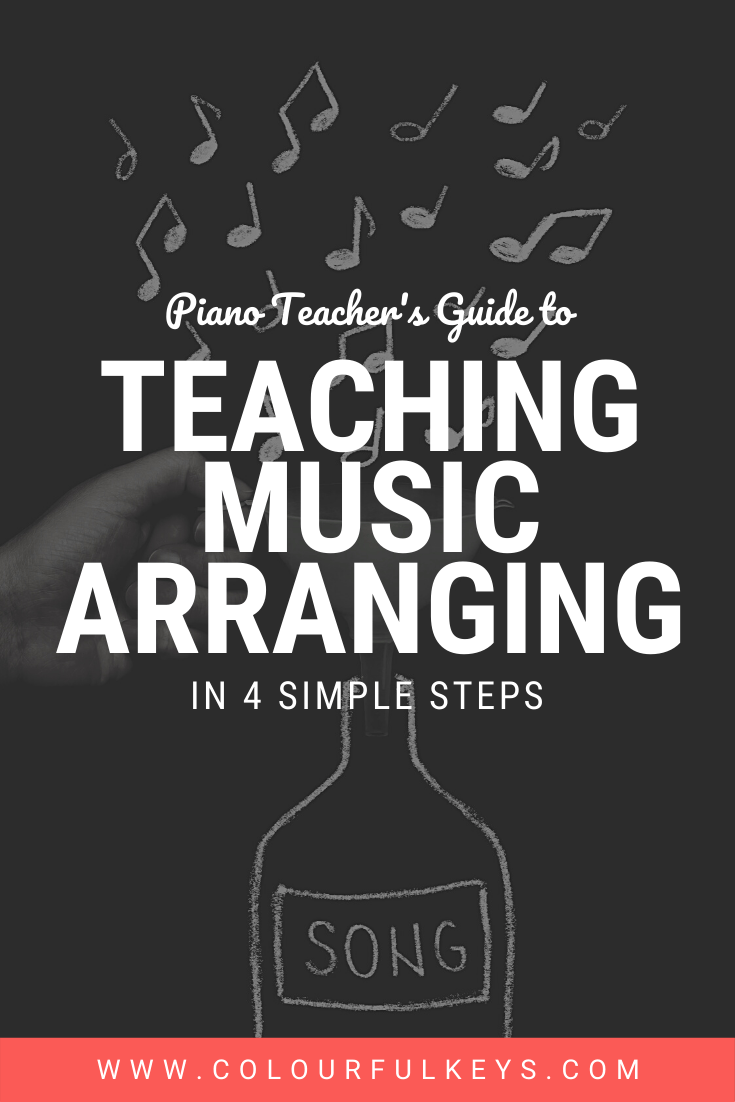
I wish many subjects could be taught this way. The excellent way you motive and challenge students encouraging them to experiment and learn more on their own is an ideal way to teach.
Pretty awesome blog and I loved the arrangements. It’s funny how many beginner students already do some of the steps presented like change the register of their song and just intuitively play with their song. I can definitely use some of the suggestions and have them experiment with different bass lines, dynamics, articulations, adding new material.
Bravo Stacy Fahrion not just for incorporating off-page creativity into your teaching but also for sharing tips on how to do it with fellow teachers. Such important work for brain development, not to mention the future of music! You’ve traveled far on your creative music making journey.